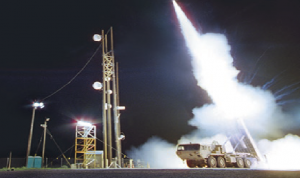Need Pricing quickly?
No problem, we have a Live team on hand to assist you. Click Start Now & enter your query.
![]()
No problem, we have a Live team on hand to assist you. Click Start Now & enter your query.
![]()


NX I-deas and Nastran allow accelerated solutions to challenging analyses.
With a critical design review of a highly complex seeker assembly approaching, an efficient method to validate the design under severe dynamic environments was required.
The Theater High Altitude Area Defense (THAAD) missile system is a transportable defensive weapon that uses precision targeting imagery to protect against hostile incoming threats such as tactical and theater ballistic missiles. BAE Systems is responsible for providing the infrared (IR) seeker subsystem containing an infrared detector, stabilized on a two-axis integrated gimbal assembly (IGA).
During operation and transportation, the seeker is subjected to severe static, random vibration, shock and thermal loads. With no margin for failure in the qualification test program, BAE Systems asked ATA Engineering, Inc. (ATA) to analytically qualify the IGA structural design for all load cases and identify any required design modifications before manufacturing.
Solving challenging structural analysis problems with superelements
One of the greatest challenges in the analysis of complex assemblies is the trade-off between model fidelity and solution time. In the case of the IGA, the dynamic response is highly sensitive to the geometric features of the parts and how they connect to one another. This eliminated the possibility of less detailed models or partby- part analyses providing accurate predictions of the dynamic loads and stresses.
To balance the need for accurate stress predictions and reduced solution time, a superelement analysis approach was used. A system dynamic model of the entire
assembly was created that included detailed finite element models of all the components. An efficient modal solution
of the assembly was achieved by representing individual subassemblies as superelements in the solution.
